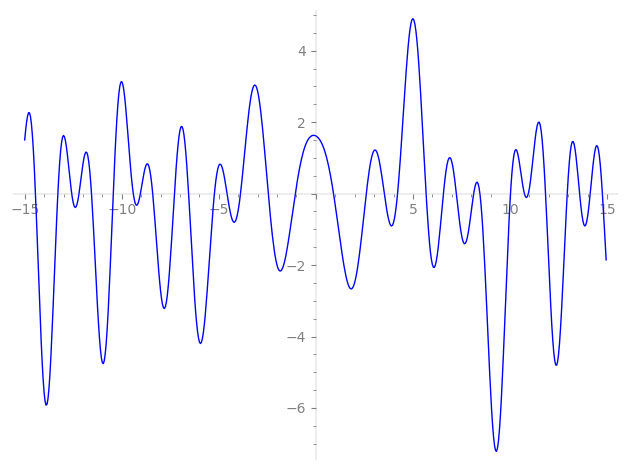| L(s) = 1 | + (0.305 + 0.528i)3-s + (−1.59 − 2.75i)5-s + 2.36i·7-s + (1.31 − 2.27i)9-s + 5.46i·11-s + (2.31 + 1.33i)13-s + (0.971 − 1.68i)15-s + (−0.552 − 0.957i)17-s + (−1.37 − 4.13i)19-s + (−1.24 + 0.720i)21-s + (2.46 + 1.42i)23-s + (−2.57 + 4.46i)25-s + 3.43·27-s + (5.63 + 3.25i)29-s + 1.01·31-s + ⋯ |
| L(s) = 1 | + (0.176 + 0.305i)3-s + (−0.712 − 1.23i)5-s + 0.893i·7-s + (0.437 − 0.758i)9-s + 1.64i·11-s + (0.643 + 0.371i)13-s + (0.250 − 0.434i)15-s + (−0.134 − 0.232i)17-s + (−0.316 − 0.948i)19-s + (−0.272 + 0.157i)21-s + (0.513 + 0.296i)23-s + (−0.514 + 0.892i)25-s + 0.660·27-s + (1.04 + 0.604i)29-s + 0.182·31-s + ⋯ |
Λ(s)=(=(1216s/2ΓC(s)L(s)(0.974−0.222i)Λ(2−s)
Λ(s)=(=(1216s/2ΓC(s+1/2)L(s)(0.974−0.222i)Λ(1−s)
| Degree: |
2 |
| Conductor: |
1216
= 26⋅19
|
| Sign: |
0.974−0.222i
|
| Analytic conductor: |
9.70980 |
| Root analytic conductor: |
3.11605 |
| Motivic weight: |
1 |
| Rational: |
no |
| Arithmetic: |
yes |
| Character: |
χ1216(639,⋅)
|
| Primitive: |
yes
|
| Self-dual: |
no
|
| Analytic rank: |
0
|
| Selberg data: |
(2, 1216, ( :1/2), 0.974−0.222i)
|
Particular Values
| L(1) |
≈ |
1.613227637 |
| L(21) |
≈ |
1.613227637 |
| L(23) |
|
not available |
| L(1) |
|
not available |
L(s)=p∏Fp(p−s)−1 | p | Fp(T) |
|---|
| bad | 2 | 1 |
| 19 | 1+(1.37+4.13i)T |
| good | 3 | 1+(−0.305−0.528i)T+(−1.5+2.59i)T2 |
| 5 | 1+(1.59+2.75i)T+(−2.5+4.33i)T2 |
| 7 | 1−2.36iT−7T2 |
| 11 | 1−5.46iT−11T2 |
| 13 | 1+(−2.31−1.33i)T+(6.5+11.2i)T2 |
| 17 | 1+(0.552+0.957i)T+(−8.5+14.7i)T2 |
| 23 | 1+(−2.46−1.42i)T+(11.5+19.9i)T2 |
| 29 | 1+(−5.63−3.25i)T+(14.5+25.1i)T2 |
| 31 | 1−1.01T+31T2 |
| 37 | 1−0.450iT−37T2 |
| 41 | 1+(−0.336+0.194i)T+(20.5−35.5i)T2 |
| 43 | 1+(−4.96+2.86i)T+(21.5−37.2i)T2 |
| 47 | 1+(−2.91−1.68i)T+(23.5+40.7i)T2 |
| 53 | 1+(−3.53−2.03i)T+(26.5+45.8i)T2 |
| 59 | 1+(−6.82−11.8i)T+(−29.5+51.0i)T2 |
| 61 | 1+(−6.77+11.7i)T+(−30.5−52.8i)T2 |
| 67 | 1+(−4.27+7.39i)T+(−33.5−58.0i)T2 |
| 71 | 1+(−1.07−1.86i)T+(−35.5+61.4i)T2 |
| 73 | 1+(−3.91−6.78i)T+(−36.5+63.2i)T2 |
| 79 | 1+(5.57+9.65i)T+(−39.5+68.4i)T2 |
| 83 | 1−4.14iT−83T2 |
| 89 | 1+(−4.19−2.41i)T+(44.5+77.0i)T2 |
| 97 | 1+(0.641−0.370i)T+(48.5−84.0i)T2 |
| show more | |
| show less | |
L(s)=p∏ j=1∏2(1−αj,pp−s)−1
Imaginary part of the first few zeros on the critical line
−9.406494048585345217755116736007, −9.040383673355449493566471334869, −8.406421134717823629249745723439, −7.28640376174527422467256990870, −6.55772624891666170416023108940, −5.22757972099651206888870742811, −4.57627878100346871250014223896, −3.88352876759695211646979256546, −2.45180527208939842868713003167, −1.06039411880304173487539663637,
0.907202853264175129552706536982, 2.59522486721728578693300738131, 3.52422571431006747144923502725, 4.20588463126734674923052319824, 5.67599942130219062127587902708, 6.56828564491659444012974343453, 7.23385594805841599856045740109, 8.128016120950141266878141323846, 8.447133588618260757867622428812, 10.02312613072430396577888081315

